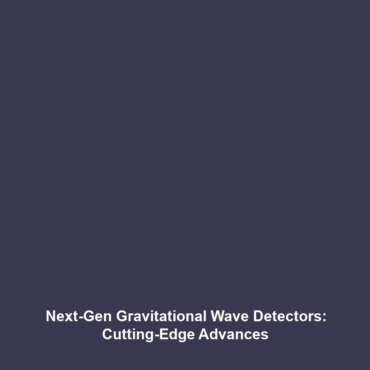Next-Generation Detectors: Advances in Gravitational Wave Detection Technology
Introduction
The detection of gravitational waves marks a revolutionary leap in astrophysics, enabling scientists to observe cosmic events beyond the capabilities of traditional telescopes. Next-generation detectors are at the forefront of this evolution, incorporating cutting-edge technologies that enhance sensitivity and accuracy. These advancements are critical for expanding our understanding of phenomena such as black hole mergers and neutron star collisions. As we delve into the realm of gravitational waves, it becomes evident that these next-generation detectors are pivotal for unraveling the mysteries of the universe.
Key Concepts
Principles of Gravitational Wave Detection
Gravitational waves are ripples in spacetime caused by violent astrophysical events. The foundation of gravitational wave detection relies on the principles of general relativity. Next-generation detectors, such as the proposed Einstein Telescope and LIGO upgrades, utilize sophisticated laser interferometry techniques to measure minute changes in distance caused by passing gravitational waves.
Technology Innovations
These next-generation detectors boast advances in several areas, including:
- Increased Sensitivity: Enhancements in mirror coatings and seismic isolation systems provide improved sensitivity, allowing for the detection of fainter gravitational waves.
- Wavelength Optimization: Utilizing different wavelengths can provide better access to various gravitational wave sources.
- Multi-Messenger Astronomy: Integration with electromagnetic observations facilitates a broader understanding of cosmic events.
Applications and Real-World Uses
Next-generation detectors play a crucial role in various real-world applications related to gravitational waves, including:
- Astronomical Discoveries: Understanding the dynamics of black holes and neutron stars through their merging events.
- Cosmology: Probing the early universe and dark matter by analyzing gravitational wave signals.
- Fundamental Physics: Testing the limits of general relativity and studying the properties of spacetime.
Current Challenges
Despite the progress, the field faces several challenges:
- The high costs associated with developing and deploying next-generation detectors.
- Environmental Interference: Vibrations and seismic activities can disrupt measurements.
- Data Analysis: The volume of data generated necessitates advanced algorithms and computational resources.
- Collaboration across institutions to optimize detector networks and improve detection rates.
Future Research and Innovations
Research into next-generation detectors is rapidly advancing. Some promising directions include:
- Space-Based Detectors: Projects like LISA (Laser Interferometer Space Antenna) aim to implement gravitational wave detection in space to reduce Earth-based noise.
- Artificial Intelligence: Leveraging AI and machine learning for improved data analysis and event classification.
- Hybrid Detectors: Combining multiple detection techniques to enhance sensitivity and broaden detection range.
Conclusion
Next-generation detectors signify a remarkable advancement in the study of gravitational waves, promising to greatly enhance our understanding of the universe. As technologies improve, the potential for groundbreaking discoveries in astrophysics increases. For those interested in the cutting-edge intersection of physics and astronomy, engaging with this evolving field cannot be overstated. To learn more about gravitational waves and related technologies, visit our related topics page.

Leave a Reply